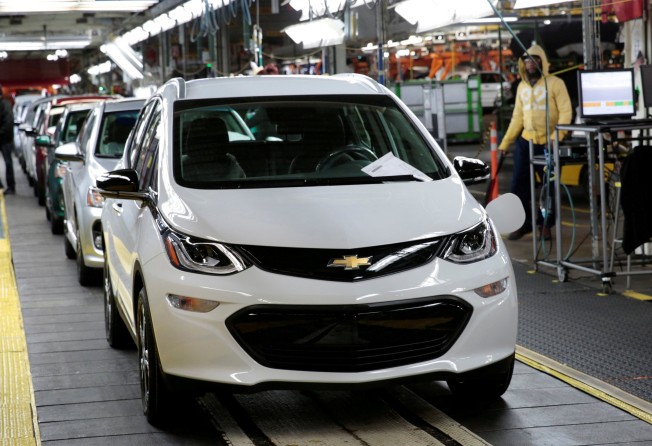
General Motors to lay off 15 per cent of salaried workers, halt production at five plants in US, Canada
- Move is part of a sweeping realignment as car maker turns toward electric vehicles
- US President Donald Trump says company should stop making cars in China

General Motors Co said on Monday it would cut production of slow-selling models and slash its North American workforce in the face of a stagnant market for traditional gas-powered sedans, shifting more investment to electric and autonomous vehicles.
The announcement is the biggest restructuring in North America for the No. 1 car maker in the US since its bankruptcy a decade ago. Its shares rallied 7.6 per cent to $38.66 in late morning trading.
GM plans to halt production next year at three assembly plants – Lordstown, Ohio; Hamtramck, Michigan; and Oshawa, Ontario. The company also plans to stop building several models now assembled at those plants, including the Chevrolet Cruze, the Cadillac CT6 and the Buick LaCrosse. The Cruze compact car will be discontinued in the US market in 2019.

Plants in Baltimore, Maryland, and Warren, Michigan, that assemble power train components will have no products assigned to them after 2019 and thus are at risk of closure, the company said. It will also close two factories outside North America, but did not identify them.
“We are right-sizing capacity for the realities of the marketplace,” Chief Executive Mary Barra said, adding that the cuts were prompted by auto industry changes. Barra said the company would double resources dedicated to electric and self-driving vehicles over the next two years.
The United Auto Workers union vowed to “confront this decision by GM through every legal, contractual and collective bargaining avenue open to our membership.”
“General Motors’ decision today to stop production at the Lordstown, Ohio, and Hamtramck, Michigan, assembly plants will idle thousands of workers, and will not go unchallenged by the UAW,” Terry Dittes, UAW Vice President in charge of negotiations with GM, said.
US President Donald Trump told The Wall Street Journal on Monday that General Motors Co should stop making cars in China and make them in the United States instead.
Trump told reporters he was not happy with GM’s decision to idle the Lordstown plant and that GM had “better put something else” in Ohio.
He said he told Barra he was unhappy with the announcement.
She told him the decision to halt sales of the Chevrolet Cruze had “nothing to do with tariffs” but was because of poor sales. “Get a car that is selling well and put it back in,” Trump said.
In a statement, Detroit Mayor Mike Duggan described the news as “troubling” and said that the city’s economic development team and the UAW are “working together to come up with a solution that works for GM and the employees”.
Canadian Prime Minister Justin Trudeau said he spoke with Barra and expressed “deep disappointment”.
GM said it will take pre-tax charges of US$3 billion to US$3.8 billion to pay for the cutbacks, but expects the actions to improve annual free cash flow by US$6 billion by the end of 2020.
Its North American salaried workforce, including engineers and executives, will shrink by 15 per cent, or about 8,000 jobs. The company said it will cut executive ranks by 25 per cent to “streamline decision making.”

Even as GM is moving to lay off salaried staff, the company is hiring. At GM’s Detroit headquarters on Monday, there were signs directing people to a “New Hire Orientation” meeting.
Barra said that GM could reduce annual capital spending by US$1.5 billion and increase investment in electric and autonomous vehicles and connected vehicle technology because it has largely completed investing in new generations of trucks and sport utility vehicles.
Some 75 percent of its global sales will come from just five vehicle architectures by the early 2020s.
GM plans to reduce annual capital spending to US$7 billion by 2020 from an average of US$8.5 billion a year during the 2017-2019 period.
Cost pressures on GM and other car makers and suppliers have increased as demand waned for traditional sedans. The company has said tariffs on imported steel, imposed earlier this year by the Trump administration, have cost it US$1 billion.
Barra did not link Monday’s cuts to tariff pressures, but said trade costs are among the “headwinds” GM has to face as it deals with broader technology change and market shifts.
With US car sales lagging, several car plants have fallen to just one shift, including its Hamtramck and Lordstown, assembly plant.
A rule of thumb for the automotive industry is that if a plant is running below 80 percent of production capacity, it is losing money. GM has several plants running well below that. Consultancy LMC estimates that Lordstown will operate at just 31 percent of production capacity in 2018.
Barra said that GM is running at about 70 percent capacity utilisation in North America, and that the company will provide an update on how the latest moves will improve utilisation in January.

“We need to make sure that we are well positioned to compete, not just over the next few years, but well beyond,” she said.
Unlike its plants making passenger cars, many GM plants producing its higher-margin trucks and SUVs are running on three shifts, with some running six and sometimes seven days a week to keep up with demand.
GM’s rivals, Ford Motor Co and Fiat Chrysler Automobiles NV, have both curtailed US car production. Ford said in April it planned to stop building nearly all cars in North America, preferring to focus on SUVs and pickup trucks.
The industrywide slowdown in passenger car sales started to pick up steam in 2017.
US consumer preferences have shifted away from passenger cars to larger, more comfortable SUVs and pickup trucks has been swift and severe, leaving car makers scrambling to readjust.
As recently as 2012, passenger cars made up more than 50 per cent of all US new vehicle sales. Through the first nine months of 2018, though, that had fallen to a little over 31 per cent.
While industry-wide passenger car sales were down 13.2 per cent through the first nine months of the year, pickup truck and SUV sales rose 8.3 per cent. As well as being roomier than sedans, SUVs and crossovers have seen their fuel economy improve significantly.
Sales of the Cruze, built at Lordstown, fell 27 per cent through September 2018. Sales of the Impala, which is built at Oshawa and Hamtramck, were down 13 per cent. Those of the Buick LaCrosse and the Cadillac CT6, which are built at Hamtramck, were down 14 per cent and 11 per cent, respectively.